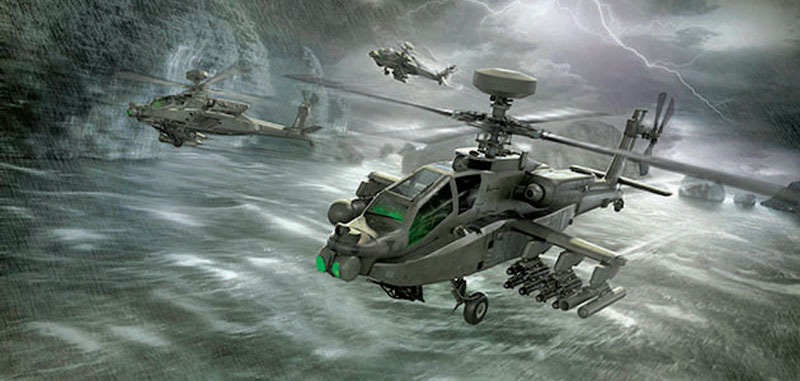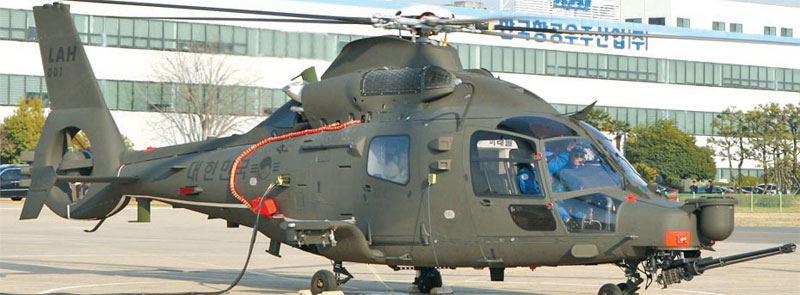Close air support is vital mission performed by helicopters and many new ones are in offing
Atul Chandra
Close Air Support (CAS) is an important battlefield role for military helicopters and the role is fulfilled by a variety of helicopters operational with the Indian Army and Indian Air Force (IAF). At the same time, the importance of this role and the need for armed and attack helicopters that can operate in future battlefields have meant that India has to keep abreast of important developments and procure new platforms.

The Indian military operates a wide range of armed and attack helicopters. Among the armed helicopters are the Russian-made Mi-171V and Mi-17V5, and the indigenously-developed Dhruv MkIV Rudra. India’s attack helicopters comprise the Boeing AH-64E Apache, Light Combat Helicopter Prachanda and a declining number of Mil Mi-35s. The induction of the indigenously-developed Rudra and Prachanda helicopters along with the Apaches will dramatically increase the CAS capability of the Indian armed forces.
While India now has the capability to develop its own range of armed and attack helicopters, the difficulties in rotorcraft development have resulted in even countries with an advanced aerospace ecosystem having to partner with foreign OEMs to meet their requirements.
Speedy Development
One such example is South Korea, which is following a two-pronged approach of developing a new commercial and military helicopter based on an existing design. Airbus Helicopters was selected in 2015 to partner Korea Aerospace Industries (KAI) in developing two 5-ton class rotorcraft that meet the South Korean requirements for a next-generation Light Civil Helicopter (LCH) and Light Armed Helicopter (LAH). Both the LCH and the LAH are based on Airbus Helicopters’ H155 (formerly known as the EC155), which is the latest evolution of its best-selling Dauphin family, which includes the Panther military variant. The LAH and the LCH will have commonality of more than 60 per cent.
Airbus Helicopters is transferring its technical know-how for the programme and the LCH was originally expected to enter service in 2020 and the LAH in 2022. The LAH and the LCH developmental programme is an integrated South Korean civil and military helicopter development project run by KAI jointly with the South Korean Ministry of Trade, Industry and Energy, and the Defence Acquisition Programme Administration.
The KAI started development of the LAH in June 2015 and the first prototype was unveiled in December 2018, three years and six months after development started. The LAH was declared suitable for provisional combat use in December 2020. The KAI bagged a USD 325 million order from Korea’s Defence Acquisition Programme Administration in December 2022 for the LAH. The delivery of the first of 10 helicopters will take place in 2024. The LAH is equipped with a state-of-the-art avionics suite and powered by two 1,032 horsepower-class engines. The new armed helicopters will replace MDthe-500 helicopters and AH-1S attack helicopters in service with the Korean military.
Procurement Fast Track
Thailand opted for Boeing’s unique AH-6i light attack reconnaissance helicopters in February 2022 to replace the Royal Thai Army’s (RTA) ageing fleet of seven AH-IF Cobra helicopters. As part of Thailand’s broader military modernisation effort, the new AH-6i helicopters will provide light attack reconnaissance for CAS to special operations forces, Stryker infantry soldiers and border guard units. The RTA is the second international customer of the AH-6i and under the USD 103 million contract Boeing will deliver eight helicopters, spares, training devices, support equipment and technical publications. Boeing is to deliver the first AH-6i to Thailand in 2024.
The AH-6i offers an unmatched power-to-weight ratio and features an extensive, integrated digital communications suite along with an advanced mission computer that can process heavy data as well as quickly share system information with other platforms. Though small in size, the AH-6i packs a heavy punch and is armed with AGM-114R Hellfire missiles; Advance Precision Kill Weapon System rockets, M134 Mini Guns/GAU-19/B .50 Cal machine guns and M260 Rocket Launchers.
In an important milestone for the Apache attack helicopter programme, in October 2022 Boeing delivered the first AH-64E Version 6, or v6 Apache helicopter to the Royal Netherlands Air Force (RNLAF). The AH-64E v6 features improved performance, sensors and software and delivers a significant increase in attack power, versatility and situational awareness. The AH-64E v6 is the most modern configuration of the Apache and is a network-centric, fully integrated weapon system specifically built to dominate in highly contested and complex battle space. The Version 6 Apache includes multiple enhancements to the aircraft’s sensors, software and weapons performance. Boeing is targeting the delivery of the final E-model Apache to the Netherlands in 2025. Boeing had received a contract in 2019 to remanufacture 28 RNLAF AH-64 D-model Apaches to the advanced AH-64E v6.

Dauphin family
Modernised Apache Concept
In October 2022, Boeing unveiled the ‘Modernized Apache’ concept which will be a dramatic advance over the existing AH-64E Apache attack helicopter. While the AH-64E is scheduled to remain in production until at 2028, it is will remain in service with the US Army and its partner nations into the 2060s.
The modernized Apache concept represents the next evolution of the current AH-64E v6 and is being proposed to the US Army as a dominant, affordable concept built on the combat-proven Apache platform. The US Army is looking to maintain its rotorcraft dominance in future Multi-Domain Operations (MDO). The Modernized Apache will embrace and integrate cutting-edge technology to keep delivering the options and tools needed to support soldiers on the ground. Boeing is offering six modernisation elements within the framework for the Apache’s evolution into the modernised concept to offer the blueprint for continued dominance:
- Drivetrain upgrades to unlock Improved Turbine Engine (ITE) capabilities for enhanced power, range, efficiency and speed;
- A Modular Open Systems Approach for maximum interoperability and faster integration and fielding of advanced capabilities;
- Advanced mission systems to increase interoperability to the network and to reduce pilot cognitive strain and workload during operations;
- Advanced sensors and sensor fusion for better and more resilient connectivity across domains and operations in all environmental conditions;
- Airborne long-range precision munitions, Air Launched Effects (ALE) and potential future directed energy weapon system integration for increased lethality; and
- Advanced sustainment through a more capable and lower life cycle cost airframe, as well as affordable remanufacture and minimized procurement costs.
- Accelerating the digital revolution
The Modernised Apache concept will be capable of seamlessly and effectively meeting the US Army’s evolving attack and reconnaissance requirements, which include increased agility, interoperability, lethality, survivability and reach. It will also leverage Boeing’s established, worldwide industrial base, which is already mature and in place to support future Apache engineering, manufacturing, development and production.
French Flavour
The next generation armed helicopter for the French military will be the Airbus Helicopters H160M Guépard. Deliveries to the French army are to begin in 2027 and the new helicopters will be adapted to meet the needs of modern warfare thanks to increased connectivity, manoeuvrability, low acoustic footprint and a fully integrated support system. The H160M is derived from the civil EASA-certified H160. The H160 was designed to be a modular helicopter, enabling its military version with a single platform to perform missions ranging from commando infiltration to air intercept, fire support and anti-ship warfare in order to meet the needs of the army, navy and the air force.
A key aspect of the H160M will be its reduced acoustic signature made possible by new rotor blades. The H160M will be equipped with Airbus Helicopters’ HForce weapon system, a modular and incremental solution enabling the use of a large choice of weapons. In addition to being equipped with Safran’s Euroflir 410 electro-optical system, the H160M will feature Thales’ FlytX cockpit avionics suite and AirMaster C radar, while its pilots will be able to use the Thales TopOwl Helmet-mounted Sight & Display. The Guépard will also carry a self-protection suite, a satellite communication system and tactical data link system.
In addition to the H160M, Airbus Helicopters will also undertake the Tiger MkIII attack helicopter upgrade programme. It received a contract in March 2022 for the upgrade of 42 aircraft for France (with the possibility to add another 25 helicopters) and 18 for Spain. Germany could also join the programme at a later date. The maiden flight for the first prototype is slated to take place in 2025 and the delivery of the first helicopter to France is slated for 2029 and to Spain in 2030. The Tiger MkIII will further improve the connectivity, precision and fire power capabilities of the current Tiger. The Tiger MkIII will be able to perform manned-unmanned teaming as well as share tactical information in real time and gain access to a new range of weapons (turret gun, laser-guided rockets and missiles) along with integration of state-of-the art avionics to reduce crew workload.

